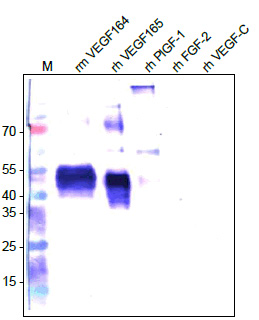CD105 (ENG) Rabbit Polyclonal Antibody
Other products for "ENG"
Specifications
| Product Data | |
| Applications | ELISA, FC, IF, IHC, WB |
| Recommended Dilution | ELISA (1-15 µg/ml). Western blot (1-5 µg/ml with the appropriate secondary reagents). FACS analysis and cell sorting (2-5 µg/ml together with the appropriate secondary reagents). Immunofluorescence/Immunohistochemistry (1-5 µg/ml). |
| Reactivities | Human |
| Host | Rabbit |
| Clonality | Polyclonal |
| Immunogen | Recombinant Human soluble CD105/Endoglin (aa. 22 (Glu) to 586 (Leu)) derived from Insect Cells (Cat.-No DA3523X). |
| Specificity | This antibody detects CD105. |
| Formulation | PBS, pH 7.4 without preservatives State: Purified State: Lyophilized purified Ig fraction |
| Reconstitution Method | Restore in sterile water to a concentration of 0.1-1.0 mg/ml |
| Purification | Protein A Chromatography |
| Conjugation | Unconjugated |
| Storage | Prior to reconstitution store at 2-8°C. Following reconstitution store undiluted at 2-8°C for one month or (in aliquots) at -20°C for longer. Avoid repeated freezing and thawing. |
| Stability | Shelf life: one year from despatch. |
| Gene Name | endoglin |
| Database Link | |
| Background | Endoglin, also known as CD105, is a Type I integral membrane glycoprotein with a large, disulfide-linked, extracellular region and a short, constitutively phosphorylated, cytoplasmic tail. Two splice variants of human Endoglin, the S-Endoglin and L-Endoglin that differ in the length of their cytoplasmic tails have been identified. Endoglin is highly expressed on vascular endothelial cells, chondrocytes, and syncytiotrophoblasts of term placenta. It is also found on activated monocytes, bone marrow pro-erythroblasts, and leukemic cells of lymphoid and myeloid lineages. Human and mouse Endoglin share approximately 70% and 97 % amino acid sequence identity in their extracellular and intracellular domains, respectively. It has clearly been shown that CD105/Endoglin is required for angiogenesis and it plays a key role in heart development. Mutations in human Endoglin or ALK-1 (another type I serine/threonine receptor) lead to the vascular disorder hereditary hemorrhagic telangiectasia (HHT). Mice heterozygous for Endoglin have been developed as disease models for HHT. Endoglin has been shown to be a powerful marker of neovascularization. It is also useful as a functional marker that defines long-term repopulating hematopoietic stem cells. |
| Synonyms | ENG, END, HHT1, ORW, ORW1 |
| Reference Data | |
Documents
| Product Manuals |
| FAQs |
| SDS |
{0} Product Review(s)
0 Product Review(s)
Submit review
Be the first one to submit a review
Product Citations
*Delivery time may vary from web posted schedule. Occasional delays may occur due to unforeseen
complexities in the preparation of your product. International customers may expect an additional 1-2 weeks
in shipping.






























































































































































































































































 Germany
Germany
 Japan
Japan
 United Kingdom
United Kingdom
 China
China







